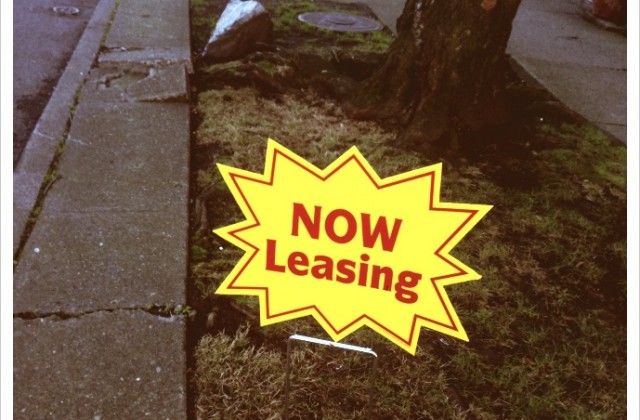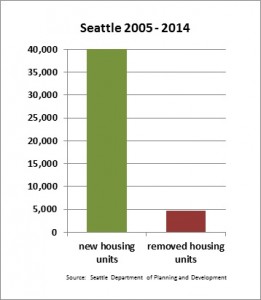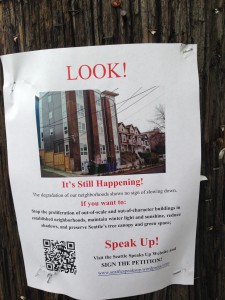Ideas for Change: Seattle’s Housing Future
The debate and discussion over housing can sometimes take an ugly turn, especially when facing opponents of small-lot housing, microhousing, and people that want jobs and housing to go somewhere else. There are days when all we do is defense, batting away the lastest half-truth about supply and demand, or arguing why we should be taking away rules rather than adding more of them to spark innovation.
But we also need something positive, a statement of how we see the future of housing in Seattle. I often get asked, “Ok, what’s your solution to all this then?” It’s a fair question. In response we’ve created Seattle’s Housing Future, the beginning of a broad citywide agenda to build more housing. When you go to the tab on the website you’ll see a page that is table of contents for a whole bunch of ideas about how to improve housing for everyone in Seattle.
Let’s be clear, this is just the beginning. Some of these things like the Multifamily Tax Exemption (MFTE) are already doing a good job of creating some housing that is affordable by HUD standards for someone earning 80 percent of Area Median Income (AMI). The program is under siege with many people calling it a give away, but almost everyone agrees it efficiently creates units accessible to people at that income level.
And here’s a term I am introducing to the mix: accessible. By accessible I do not mean compliant with the Americans with Disabilities Act, although that’s part of the idea. When I am using the term I mean housing that people can get into without experiencing a stress or strain. Some of this has to do with price, but it’s also about where the housing is and how it fits into a person’s or family’s needs in other areas like transportation.
The ideas in Seattle’s Housing Future need refinement. What do you think we missed? What’s the most important? What parts seem easy to do with the biggest impact? What elements need more explanation and development?
We’ll be trying these ideas out in the weeks ahead, looking for more ideas, and adding, subtracting, and expanding as we go. We’d like to know what you think. Share this with your networks. Convincing leaders at the City to try new ideas won’t be easy; there is a lot of worry in the Seattle over change. Ideas matter, and these ideas are a good place to start building a smart, knowlege based agenda for welcoming new jobs and people to our city.
Orientation: The Construction Codes Advisory Board
The Construction Codes Advisory Board (CCAB) is probably one of the most important City Boards that you’ve never heard of. The CCAB is the body that reviews additions and changes to the City’s building code. This matters a lot for builders, architects, engineers, and everyone in the building trades who actually have their hands dirty every day on construction sites. What kinds of things does the CCAB look at. Here’s an example:
Section 3107.11.2.1 of the Seattle Building Code states “All plastics used in signs shall be approved plastics…” This Rule clarifies what is considered an “approved plastic.”
Flexible plastics used for signs must be tested according to NFPA 701-10, Test 2. Signs that satisfy the criteria of NFPA 701 are considered “approved plastics” and are permitted to be used in signs.
Plastics shall be tested according to ASTM E84-09 or UL 723 if they are self-supporting and capable of being mounted in the test position. These materials shall have at least a Class B flame spread and smoke developed rating.
While this kind of thing seems like the height of arcana it truly does have an impact on project costs and what gets built and how. I watched the board debate and discuss extensively what this definition would mean and the impact it might have. And the people on the board know what they’re talking about; they make a living doing this work. The members include an architect, structural, electrical, and mechanical engineers, a general contractor, a building owner and operator, and a member from labor. The members take their work seriously and the staff also are helpful and knowledgable about the history of the rules, the technical background, and the broader policy implications.
I’m not a fan of more regulations, but the City, neighbors, and builders really are getting their monies worth from the CCAB. Sure, it’d be nice to get rid of a lot of these rules. But as long as we have them it’s refreshing to see hands on consideration of what these rules mean by people that know the business.
One House, One Diagram [UPDATED]
Breaking News: The black box has been found and we’ve discovered a link to the diagram. You can see it here.
Evidently, sensing their overreach, the people behind One House One Lot have started to downplay the fact that the legislation they support will dramatically impact the ability of existing homeowners to add to their own homes. They’ve posted a diagram in an effort to dampen the growing concern. One House One Lot is a group of angry neighbors intent on shutting down single-family development in Seattle. As David Neiman pointed out, the code writers at the Department of Planning and Development have been taking their dictation. I think people’s patience with a narrow group bent on their own interests is thinning.
But before I could post their diagram the One House people posted, they took it down.
As Dan Bertolet said, “oops!”
In lieu of the graphic, here’s a Facebook thread that completely refutes the premise of the lost graphic and the argument that the One House One Lot effort wouldn’t, in fact, impact people who want to add a floor or addition. Facebooks, take it away (low graphics version).
Dan Bertolet
shared a link via Roger Valdez.
Yesterday
Oops, looks like it’s a downzone for any single family lot < 3200 sf…
DPD Tried to Regulate Small Lots;You Wouldn’t Believe What Happened Next! – Smart Growth Seattle
www.seattleforgrowth.org
Over the last part of the week I kept hearing noises on social media about problems with the Department of Planning and…
David Sucher likes this.
Bill Bradburd
oops, maybe not.
www.onehomeperlot.com/…/04/Height_existing_remodels.pdf
21 hours ago · Like
Matt Gangemi
Your diagram ignores the 4′ that existing home was built over grade. Show me an older Seattle home built at-grade anywhere.
19 hours ago · Like
Matt Gangemi
Besides, we’re talking about 7% of all Seattle houses that you’re trying to down-zone. What gives you the right to do that?
19 hours ago · Like
Dan Bertolet
Bill, who made that graphic, you? Why won’t anyone put their name on it?
18 hours ago · Like · 1
Bill Bradburd
not I. http://www.onehomeperlot.com/
One Home Per Lot
www.onehomeperlot.com
Building a new house in the backyard or side yard of an existing Seattle home do…See More
18 hours ago · Like · 1
Matt Gangemi
Seriously Bill, show me one house that retrofit option will work for.
18 hours ago · Like
Dan Bertolet
Don’t expect much, Matt. Just like climate change deniers, the anti-housing activists’ modus operandi is to obfuscate, and John Fox is their guru.
18 hours ago · Like · 1
Bill Bradburd
not sure about john fox being a guru, but i’ll take your word on the linkage between Duffus infill housing and solving climate change.
17 hours ago · Edited · Like · 1
Jerry Pukasan
as a practicing architect, specializing in residential design, the graphic BB posted does not make any sense to me. I think it means zoning regulations not building code but still, the graphic is nothing but cartoon.
1, floor to floor height is not ceiling height, vaulted ceiling has a thickness too, houses main floor normally is at least 2 feet off grade, that graphic is not even realistic.
2, people live in the city to share space and to live more efficiently, my small lot neighbor should have same right and same height limit as me, many houses were built on double lot or triple lot in the pass, but now we have more population and less resources, if you don’t like seeing tall buildings too close to you, buy a bigger lot, move to sub or learn how to deal with it, people in most cities in the world know that.,
3, small lots owners pay property tax proportionally too, actually with setback limits, they can’t use their lot as much already, why bully them even more? only because you “don’t like” their 3 story skyscraper?
4, one home per lot so should there be 2 homes on a double lot ?
Seattle Times Story on Displacement: Fixing the Narrative
Many people have been expressing their annoyance with yet another story on the front page of the Seattle Times wringing its hands over the plight of displaced people in the face of what some call, “runaway growth.” Every single person in this city faced with a housing crisis deserves our compassion and help, whether they are the subject of a newspaper story or not. And that’s kind of the point of my irritation with the Times story written by Sanjay Bhatt: it’s the wrong story.
When a developer demolishes the century-old Williamsburg Court Apartments in downtown Seattle this year, 49 households will have to find new homes.
A couple of paragraphs later Bhatt writes:
The Seattle metro area is witnessing a historic boom in apartment construction: More than 7,000 units opened last year in King and Snohomish counties, including many in downtown Seattle. At least 10,000 more will open this year, and perhaps 14,000 next year.
Bhatt plays the same song, the one about the 49 units being “lost” but doesn’t bother with the thousands of new ones being created. His story is the one about how growth comes, it displaces lots of regular people minding their own business with fancy high rise towers for the rich. Of course Bhatt didn’t write those words, but the conventional wisdom in the community is that new housing causes prices to rise when we know, of course, that the opposite is the case. Furthermore, the sad cases of displacement are far outnumbered by the thousands of people who move into our city with newly created housing.
I have yet to read a story about the happy people getting the keys to their apartment after their search is over and they find that perfect place. A young couple or a retiree finding a new place in the city that fits their expectations and makes their life easy or more exciting just doesn’t make good copy. But the fact is those stories far outnumber the unfortunate cases of actual displacement. Those stories aren’t any less sad, but the press ought to report the whole picture. And here it is, again.
New housing in Seattle is not coming at the expense of existing housing, especially affordable housing. That probably isn’t consolation to the people losing their homes at the Williamsburg. But Bhatt’s story incites and support the know-nothing efforts by angry and entitled single-family homeowners in town that want to shut new housing down. Bhatt writes about the human wreckage of the Williamsburg:
“I work two jobs so that I can live in the city, but I don’t know what we’re going to do,” said Mali Lustica, 36, a hotel concierge and retail sales clerk who lives at Williamsburg Court. “I’m trying to find something else in the city, but everything is so expensive.”
But what would Lustica face when she tried to move into microhousing in the Eastlake neighborhood, an “established neighborhood?”
Yes, that’s right, total rejection. So please let Mr. Bhatt know what you think about his take. The front page of the Sunday Seattle Times is important journalism real estate. Urge him to write the full story. Yes growth can be painful, but it won’t be easier if we get mad about new housing’s impacts while clamping down on new housing. The only people that will suffer are people like Lustica who need a place to live.
Sanjay Bhatt
sbhatt@seattletimes.com
Small Lot Legislation: An Architect’s Perspective.
As an architect who specializes in housing, I occasionally get involved in discussions with DPD and the city council about land use issues. In general, I look at proposed legislation from this perspective: What kind of outcomes will the new legislation encourage? Are these good outcomes? If I’m trying to design housing using these new rules, is the code helping or hindering? Am I able to do good work?
Some of the proposed small lot legislation is fine. Much of it is highly technical language that should somewhat even the playing field and help homeowners and neighbors understand which lots have the potential to be split and developed. This will lead to fewer surprises, allow property owners a fair chance to know what they are sitting on when they sell, and allow neighbors know what they should buy if they don’t wish to see development happen next door.
Where the proposal goes off the rails is in its new development standards. The legislation contains a number of restrictive clauses that make it very difficult to build houses that have conventional geometry, logical arrangement, and employ normal construction practices. The height limits are excessively low, prohibiting normal relationships of the floor levels to porches, stoops, roof-lines, and to grade in general. Basements, are for all practical purposes banned, even though they are a typical feature of a Seattle single family home. Side facades are required to be modulated, despite the fact that typical small homes almost never modulate along the side facade. Ironically, this piece of legislation, originally intended to force small lot development to fit better into the existing building fabric, contains numerous prohibitions against building homes that fit with the typical patterns of development in in the existing fabric.
Worse still, the proposed legislation is so focused on handcuffing bad actors that no one seems to have given any consideration to this question: When you take the sum total of all of the “thou shalt not” clauses in this legislation, what is left over for people to build? The answer is an extrusion that completely fills the lot up to the setbacks. How do I know this? Because the proposal provides absolutely no exemptions for beneficial design features. There are no lot coverage or setback or structure depth exceptions for front porches, decks, stoops, eaves, or similar features that break down the massing of a house, create visual interest, increase livability, etc. Any project that provides these features does so directly at the expense of the overall development potential. Incentives matter. This proposal forces developers to choose between good design practices and a healthy pro-forma.
These defects are known to the planners at DPD. They understand them and fully appreciate them. I suspect if their mandate in writing this proposal was to come up with a way to facilitate better small lot development, the outcome would be quite different. Instead, the City leadership has a pitchfork mob at their door with a list of demands, and they have directed DPD to take dictation.
There is a better way to do this. You begin with the outcome that you want – a positive vision (a list of the things that you dislike that you would like to prohibit does not count). You look at the structural incentives, and you design a code that provides tangible rewards for people that provide desirable features in their projects. You make cracking the development potential of the site contingent on providing the desired outcomes.
As of today, if this legislation passes, we will have created small lot legislation that virtually guarantees the development of housing that is poorly designed (albeit somewhat shorter than it would have been otherwise). Perhaps if you view developers and builders as a malign force bent on destroying the fabric of our society, you think that’s the best that can be done. If, on the other hand, you view them as rational actors that respond to incentives, you realize these homes will be poorly designed because we asked them to build exactly that.
 David Neiman is the principle of Neiman Taber Architects, a residential architecture firm specializing in housing adapted to the Pacific Northwest climate. David was also been a leading (and successful) proponent of making significant changes to the multi-family code
David Neiman is the principle of Neiman Taber Architects, a residential architecture firm specializing in housing adapted to the Pacific Northwest climate. David was also been a leading (and successful) proponent of making significant changes to the multi-family code








